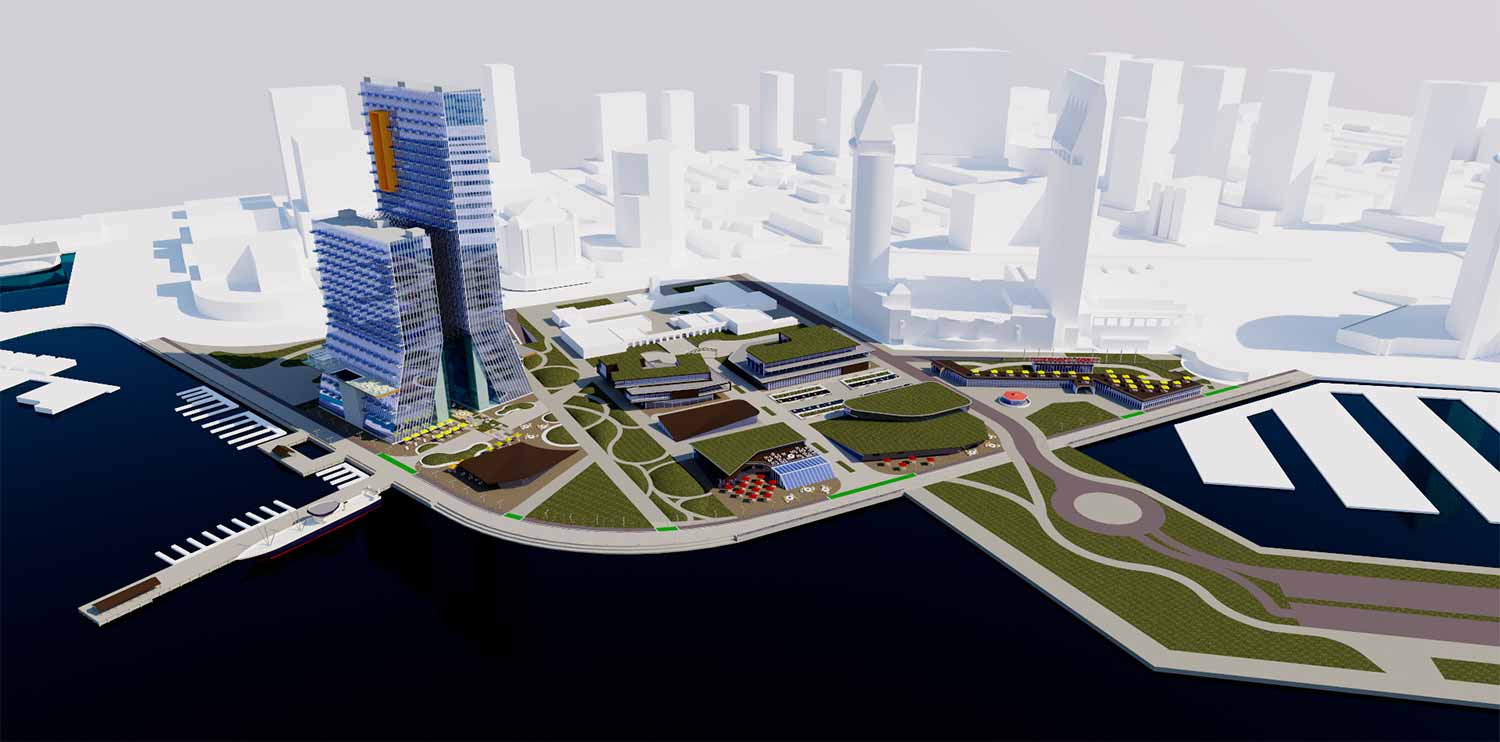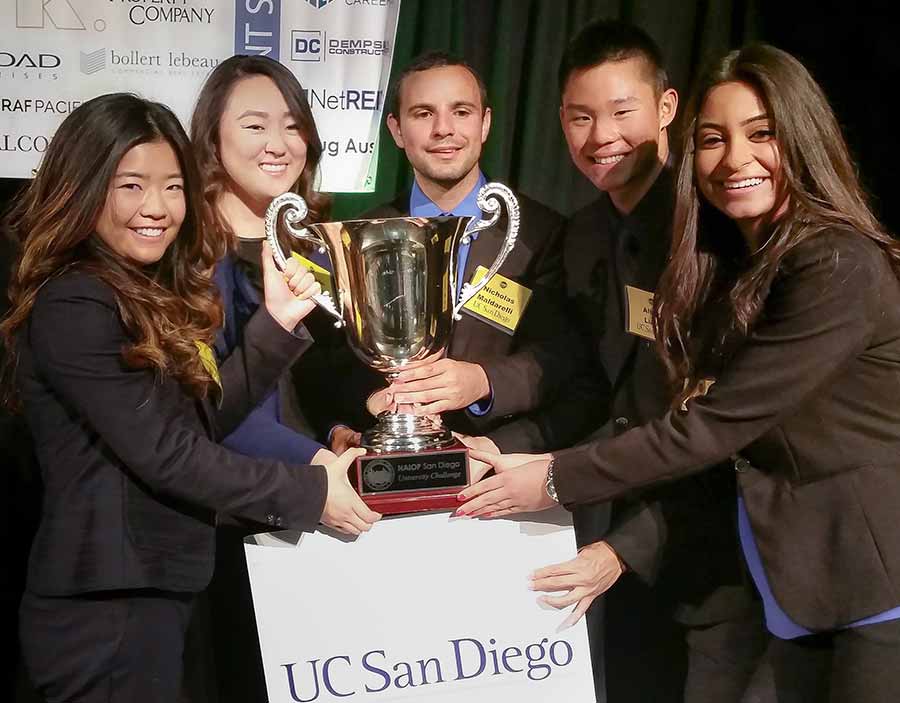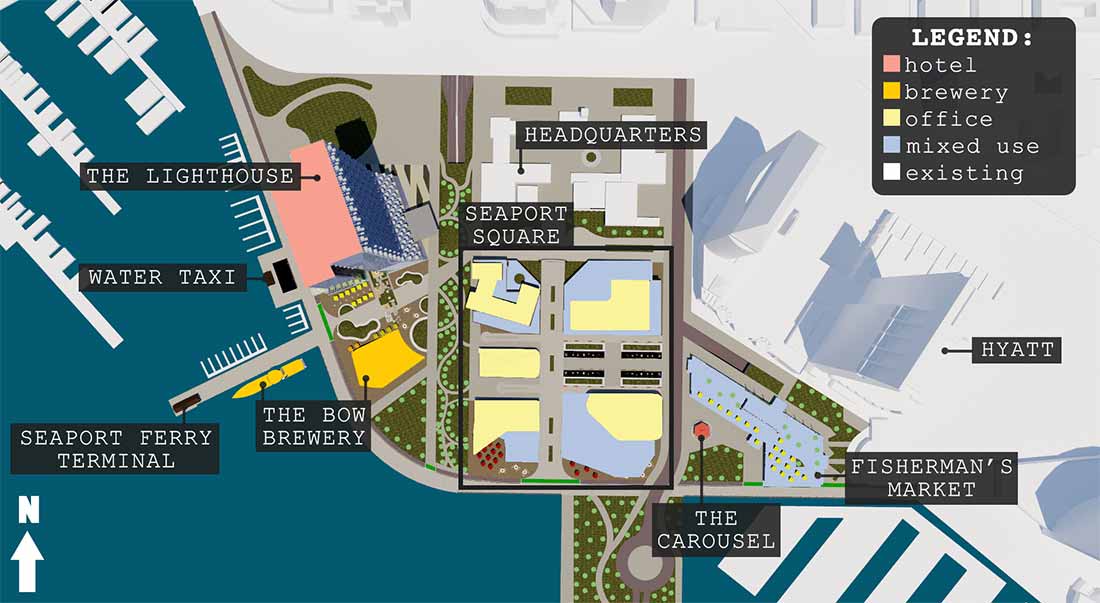Take 10 With a Triton: Roger Hailstork Returns to the Bookstore With a Focus on Accessibility
Profiles
By:
Published Date
By:
Share This:

A rendering of the winning design to redevelop Seaport Village, called "Harbor Light @ Seaport." Courtesy Triton Associates.
A team of students representing the UC San Diego Urban Studies and Planning program won the sixth annual NAIOP University Real Estate Challenge April 21. Five students from the Division of Social Sciences and Jacobs School of Engineering presented their proposal for the redevelopment of downtown’s iconic Seaport Village to a packed house and panel of judges, competing against teams from San Diego State University and the University of San Diego.

From left, Jenni Cen, Michelle Markiewicz, Nick Maldarelli, Albert Liang and Cristina Martinez with the winner's trophy. Photo by Paul Mamet.
The team’s winning proposal is called “Harbor Light @ Seaport” and includes the development of a large-scale hotel, additional retail, restaurant and office space, an open-air “Fisherman’s Market” and a maritime-specific incubator space. Judges particularly liked the team’s plan to add an iconic tower to the city’s skyline while maximizing downtown’s bay views.
Named Triton Associates, this year’s team was comprised of Urban Studies and Planning students Jenni Cen, Cristina Martinez and Michelle Markiewicz, and structural engineering students Albert Liang and Nick Maldarelli.
Mirle Rabinowitz-Bussell, Sue Peerson and Jack McGrory served as faculty advisors to the students for the competition. Rabinowitz-Bussell is the Urban Studies and Planning director of field research and associate director of the new Center for Sustainability Science, Planning and Design.
“Our team's success was the result of their own incredibly hard work and the support of many UC San Diego faculty, staff and alumni, and industry experts throughout San Diego,” Rabinowitz-Bussell said in a congratulatory letter announcing the win.
Organized each year by the San Diego chapter of the Commercial Real Estate Development Association (NAIOP), proceeds from the competition support two scholarships for each participating school. Liang was recipient of one 2015 NAIOP Foundation scholarship for his work on last year’s proposal, and returned this year to lead the team.
While proposals are often created for mock locations specific for the competition, this year’s NAIOP-led selection was intentional in that Seaport Village is currently slated for redevelopment. The UC San Diego team’s winning proposal could be used in consideration, and Liang has been approached by established developers who were impressed with what the group presented.

The student's design includes a large-scale hotel, additional retail, restaurant and office space, an open-air "Fisherman's Market" and a maritime-specific incubator space. Courtesy Triton Associates.
Developing the proposal was a long, complicated process, with the students reaching out to the public and private sectors for input on the historic downtown location. They attended community stakeholder meetings and secured non-binding letters of intent from potential tenants, including a large-scale hotel company, the Maritime Alliance, Scripps Institution of Oceanography and two restaurant development companies.
The team also took into consideration the stated desires of the Port of San Diego and local industry leaders. For instance, the Port recently announced the need for a network of parks along the San Diego bay, called a “Green Necklace.” The San Diego Regional Economic Development Corporation, with others, is also promoting a “blue economy” focused on the aquaculture, marine biotics and local fishing industries.
“Harbor Light @ Seaport is a transformation defined by three key words: design, mobility and innovation,” Liang said during the presentation. “It’s a transformation of not only Seaport Village but also San Diego and the blue economy as a whole.”
Martinez, a fourth-year student, said there were seven key factors that determined their development of the site, from serving both locals and tourists to stressing the historic relevancy of the region’s fishing industry. They considered transportation, pedestrian connectivity, green space and educational opportunities in the design development, too.
“Perhaps the most exciting feature of our site is the Blue Tech Incubator,” Martinez said. “We have 150,000 square feet of office space designated for blue-tech and maritime-related companies. Blue tech is one of the fastest-growing industries, and is the largest innovation cluster in San Diego.”
The team cited the 2012 San Diego Maritime Industry Report that urged for the creation of a marine-focused incubation space in helping drive their focus. They propose creating a Center for Maritime Excellence, or what they’re calling “the largest, greatest maritime technology center in the world.”
“This is the hub of our Blue Tech Incubator,” Martinez said, “where these blue-tech start-up companies can innovate, collaborate, showcase their work to the public and begin to thrive in the blue economy.”
View the team’s complete Harbor Light plan, including the letters of interest and vision, on the Triton Associates website.
Share This:
Keep up with all the latest from UC San Diego. Subscribe to the newsletter today.